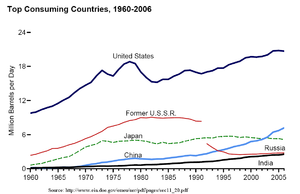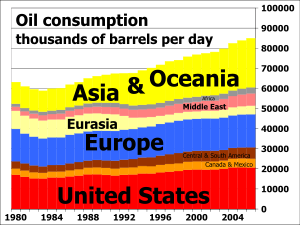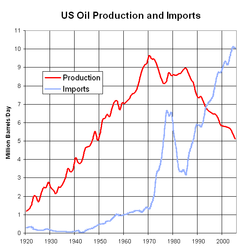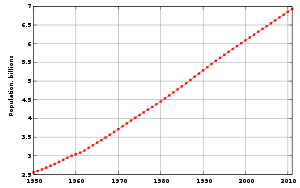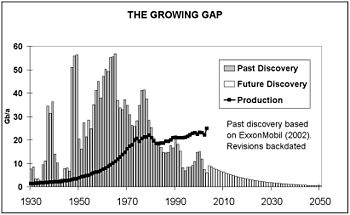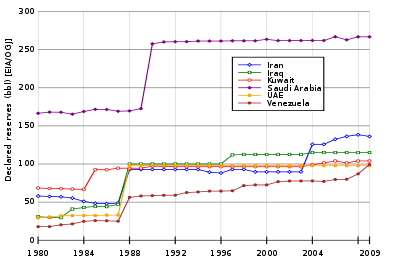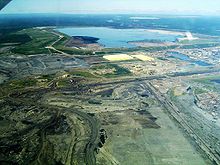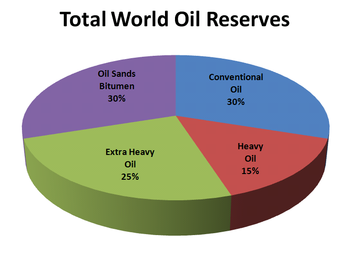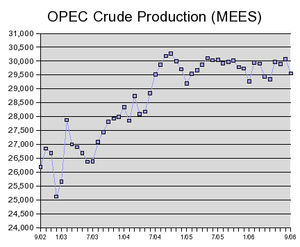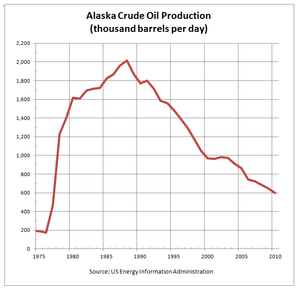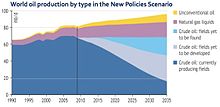- Peak oil
-
 A logistic distribution shaped production curve, as originally suggested by M. King Hubbert in 1956.
A logistic distribution shaped production curve, as originally suggested by M. King Hubbert in 1956.
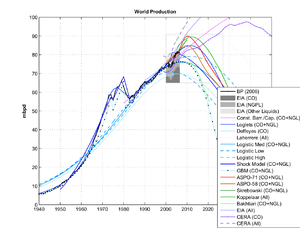 Peak oil depletion scenarios graph, which depicts cumulative published depletion studies by the ASPO and other depletion analysts (Oil Shock Model is elaborated in "The Oil Conundrum").
Peak oil depletion scenarios graph, which depicts cumulative published depletion studies by the ASPO and other depletion analysts (Oil Shock Model is elaborated in "The Oil Conundrum").
Peak oil is the point in time when the maximum rate of global petroleum extraction is reached, after which the rate of production enters terminal decline. This concept is based on the observed production rates of individual oil wells, projected reserves and the combined production rate of a field of related oil wells. The aggregate production rate from an oil field over time usually grows exponentially until the rate peaks and then declines—sometimes rapidly—until the field is depleted. This concept is derived from the Hubbert curve, and has been shown to be applicable to the sum of a nation’s domestic production rate, and is similarly applied to the global rate of petroleum production. Peak oil is often confused with oil depletion; peak oil is the point of maximum production while depletion refers to a period of falling reserves and supply.
M. King Hubbert created and first used the models behind peak oil in 1956 to accurately predict that United States oil production would peak between 1965 and 1970.[1] His logistic model, now called Hubbert peak theory, and its variants have described with reasonable accuracy the peak and decline of production from oil wells, fields, regions, and countries,[2] and has also proved useful in other limited-resource production-domains. According to the Hubbert model, the production rate of a limited resource will follow a roughly symmetrical logistic distribution curve (sometimes incorrectly compared to a bell-shaped curve) based on the limits of exploitability and market pressures.
Some observers, such as petroleum industry experts Kenneth S. Deffeyes and Matthew Simmons, predict negative global economy implications following a post-peak production decline—and oil price increase—due to the high dependence of most modern industrial transport, agricultural, and industrial systems on the low cost and high availability of oil. Predictions vary greatly as to what exactly these negative effects would be.
Optimistic estimations of peak production forecast the global decline will begin by 2020 or later, and assume major investments in alternatives will occur before a crisis, without requiring major changes in the lifestyle of heavily oil-consuming nations. These models show the price of oil at first escalating and then retreating as other types of fuel and energy sources are used.[3] Pessimistic predictions of future oil production operate on the thesis that either the peak has already occurred,[4][5][6][7] that oil production is on the cusp of the peak, or that it will occur shortly.[8][9] Production of conventional crude oil peaked in 2004 at 74 million barrels per day, and greater records reached since then represent only small increases that are failing to keep pace with demand from growing countries, such as China and India.[10][11][12][13] Throughout the first two quarters of 2008, there were signs that a global recession was being made worse by a series of record oil prices.[14]
Contents
Demand for oil
Further information: Oil consumption rates, Industrialization, and Developing countriesThe demand side of peak oil is concerned with the consumption over time, and the growth of this demand. World crude oil demand grew an average of 1.76% per year from 1994 to 2006, with a high of 3.4% in 2003-2004. After reaching a high of 85.6 million barrels (13,610,000 m3) per day in 2007, world consumption decreased in both 2008 and 2009 by a total of 1.8%, due to rising fuel costs.[15] Despite this lull, world demand for oil is projected to increase 21% over 2007 levels by 2030 (104 million barrels per day (16.5×106 m3/d) from 86 million barrels (13.7×106 m3)), due in large part to increases in demand from the transportation sector.[16][17][18] A study published in the journal Energy Policy predicted demand would surpass supply by 2015 (unless constrained by strong recession pressures caused by reduced supply).[9]
Energy demand is distributed amongst four broad sectors: transportation, residential, commercial, and industrial.[19][20] In terms of oil use, transportation is the largest sector and the one that has seen the largest growth in demand in recent decades. This growth has largely come from new demand for personal-use vehicles powered by internal combustion engines.[21] This sector also has the highest consumption rates, accounting for approximately 68.9% of the oil used in the United States in 2006,[22] and 55% of oil use worldwide as documented in the Hirsch report. Transportation is therefore of particular interest to those seeking to mitigate the effects of peak oil.Although demand growth is highest in the developing world,[23] the United States is the world's largest consumer of petroleum. Between 1995 and 2005, U.S. consumption grew from 17,700,000 barrels per day (2,810,000 m3/d) to 20,700,000 barrels per day (3,290,000 m3/d), a 3,000,000 barrels per day (480,000 m3/d) increase. China, by comparison, increased consumption from 3,400,000 barrels per day (540,000 m3/d) to 7,000,000 barrels per day (1,100,000 m3/d), an increase of 3,600,000 barrels per day (570,000 m3/d), in the same time frame.[24]
As countries develop, industry and higher living standards drive up energy use, most often of oil. Thriving economies, such as China and India, are quickly becoming large oil consumers.[25] China has seen oil consumption grow by 8% yearly since 2002, doubling from 1996-2006.[23] In 2008, auto sales in China were expected to grow by as much as 15-20%, resulting in part from economic growth rates of over 10% for five years in a row.[26]
Although swift, continued growth in China is often predicted, others predict China's export-dominated economy will not continue such growth trends due to wage and price inflation and reduced demand from the United States.[27] India's oil imports are expected to more than triple from 2005 levels by 2020, rising to 5 million barrels per day (790×103 m3/d).[28]
The International Energy Agency estimated in January 2009 that oil demand fell in 2008 by 0.3%, and that it would fall by 0.6% in 2009. Oil consumption had not fallen for two years in a row since 1982-1983.[29]
The Energy Information Administration (EIA) estimated that the United States' demand for petroleum-based transportation fuels fell 7.1% in 2008, which is "the steepest one-year decline since at least 1950." The agency stated that gasoline usage in the United States may have peaked in 2007, in part due to increasing interest in and mandates for use of biofuels and energy efficiency.[30][31]
The EIA now expects global oil demand to increase by about 1,600,000 barrels per day (250,000 m3/d) in 2010. Asian economies, in particular China, will lead the increase.[32] China’s oil demand may rise more than 5% compared with a 3.7% gain in 2009, the CNPC said.[33]
Population
Another significant factor on petroleum demand has been human population growth. Oil production per capita peaked in 1979.[34] The United States Census Bureau predicts that the world population in 2030 will be almost double that of 1980.[35] Author Matt Savinar predicts that oil production in 2030 will have declined back to 1980 levels as worldwide demand for oil significantly out-paces production.[36][37] Physicist Albert Bartlett argues that the decline of the rate of oil production per capita has gone undiscussed because population control is considered politically incorrect by some.[38]
Oil production per capita has declined from 5.26 barrels per year (0.836 m3/a) in 1980 to 4.44 barrels per year (0.706 m3/a) in 1993,[35][39] but then increased to 4.79 barrels per year (0.762 m3/a) in 2005.[35][39] In 2006, the world oil production took a downturn from 84.631 to 84.597 million barrels per day (13.4553×106 to 13.4498×106 m3/d) although population has continued to increase. This has caused the oil production per capita to drop again to 4.73 barrels per year (0.752 m3/a).[35][39]
One factor that has so far helped ameliorate the effect of population growth on demand is the decline of population growth rate since the 1970s. In 1970, the population grew at 2.1%. By 2007, the growth rate had declined to 1.167%.[40] However, oil production was, until 2005, still outpacing population growth to meet demand. World population grew by 6.2% from 6.07 billion in 2000 to 6.45 billion in 2005,[35] whereas according to BP, global oil production during that same period increased from 74.9 to 81.1 million barrels (11.91×106 to 12.89×106 m3), or by 8.2%.[41] or according to EIA, from 77.762 to 84.631 million barrels (12.3632×106 to 13.4553×106 m3), or by 8.8%.[39]
Agricultural effects and population limits
Further information: Food vs fuel, 2007–2008 world food price crisis, Energy and agriculture, and Food securitySince supplies of oil and gas are essential to modern agriculture techniques, a fall in global oil supplies could cause spiking food prices and unprecedented famine in the coming decades.[42][note 1] Geologist Dale Allen Pfeiffer contends that current population levels are unsustainable, and that to achieve a sustainable economy and avert disaster the United States population would have to be reduced by at least one-third, and world population by two-thirds.[43][44]
The largest consumer of fossil fuels in modern agriculture is ammonia production (for fertilizer) via the Haber process, which is essential to high-yielding intensive agriculture. The specific fossil fuel input to fertilizer production is primarily natural gas, to provide hydrogen via steam reforming. Given sufficient supplies of renewable electricity, hydrogen can be generated without fossil fuels using methods such as electrolysis. For example, the Vemork hydroelectric plant in Norway used its surplus electricity output to generate renewable ammonia from 1911 to 1971.[45]
Iceland currently generates ammonia using the electrical output from its hydroelectric and geothermal power plants, because Iceland has those resources in abundance while having no domestic hydrocarbon resources, and a high cost for importing natural gas.[46]
Supply of oil
Discoveries
“ All the easy oil and gas in the world has pretty much been found. Now comes the harder work in finding and producing oil from more challenging environments and work areas. ” — William J. Cummings, Exxon-Mobil company spokesman, December 2005[47]“ It is pretty clear that there is not much chance of finding any significant quantity of new cheap oil. Any new or unconventional oil is going to be expensive. ” — Lord Ron Oxburgh, a former chairman of Shell, October 2008[48]To pump oil, it first needs to be discovered. The peak of world oilfield discoveries occurred in 1965[49] at around 55 billion barrels (8.7×109 m3)(Gb)/year.[50] According to the Association for the Study of Peak Oil and Gas (ASPO), the rate of discovery has been falling steadily since. Less than 10 Gb/yr of oil were discovered each year between 2002-2007.[51] According to a 2010 Reuters article, the annual rate of discovery of new fields has remained remarkably constant at 15-20 Gb/yr.[52]
Reserves
Main articles: Oil reserves and List of largest oil fields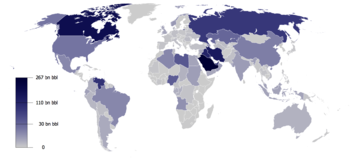 Proven oil reserves, 2009.
Proven oil reserves, 2009.
 2004 U.S. government predictions for oil production other than in OPEC and the former Soviet Union.
2004 U.S. government predictions for oil production other than in OPEC and the former Soviet Union.
Total possible conventional crude oil reserves include all crude oil with 90-95% certainty of being technically possible to produce (from reservoirs through a wellbore using primary, secondary, improved, enhanced, or tertiary methods), all crude with a 50% probability of being produced in the future, and discovered reserves which have a 5-10% possibility of being produced in the future. These are referred to as 1P/Proven (90-95%), 2P/Probable (50%), and 3P/Possible (5-10%).[53] This does not include liquids extracted from mined solids or gasses (oil sands, oil shales, gas-to-liquid processes, or coal-to-liquid processes).[54]
Many current 2P calculations predict reserves to be between 1150-1350 Gb, but because of misinformation, withheld information, and misleading reserve calculations, it has been reported that 2P reserves are likely nearer to 850-900 Gb.[5][9] Reserves in effect peaked in 1980, when production first surpassed new discoveries, though creative methods of recalculating reserves have made this difficult to establish exactly.[5]
Current technology is capable of extracting about 40% of the oil from most wells. Some speculate that future technology will make further extraction possible,[55][verification needed] but this future technology is usually already considered in Proven and Probable (2P) reserve numbers.
In many major producing countries, the majority of reserves claims have not been subject to outside audit or examination. Most of the easy-to-extract oil has been found.[47] Recent price increases have led to oil exploration in areas where extraction is much more expensive, such as in extremely deep wells, extreme downhole temperatures, and environmentally sensitive areas or where high technology will be required to extract the oil. A lower rate of discoveries per explorations has led to a shortage of drilling rigs, increases in steel prices, and overall increases in costs due to complexity.[56][57]
Concerns over stated reserves
“ [World] reserves are confused and in fact inflated. Many of the so-called reserves are in fact resources. They're not delineated, they're not accessible, they’re not available for production. ” — Sadad I. Al-Husseini, former VP of Aramco, presentation to the Oil and Money conference, October 2007.[6]Al-Husseini estimated that 300 billion barrels (48×109 m3) of the world's 1,200 billion barrels (190×109 m3) of proven reserves should be recategorized as speculative resources.[6]
One difficulty in forecasting the date of peak oil is the opacity surrounding the oil reserves classified as 'proven'. Many worrying signs concerning the depletion of proven reserves have emerged in recent years.[58][59] This was best exemplified by the 2004 scandal surrounding the 'evaporation' of 20% of Shell's reserves.[60]
For the most part, proven reserves are stated by the oil companies, the producer states and the consumer states. All three have reasons to overstate their proven reserves: oil companies may look to increase their potential worth; producer countries gain a stronger international stature; and governments of consumer countries may seek a means to foster sentiments of security and stability within their economies and among consumers.
Major discrepancies arise from accuracy issues with OPEC's self-reported numbers. Besides the possibility that these nations have overstated their reserves for political reasons (during periods of no substantial discoveries), over 70 nations also follow a practice of not reducing their reserves to account for yearly production. Analysts have suggested that OPEC member nations have economic incentives to exaggerate their reserves, as the OPEC quota system allows greater output for countries with greater reserves.[55]
Kuwait, for example, was reported in the January 2006 issue of Petroleum Intelligence Weekly to have only 48 billion barrels (7.6×109 m3) in reserve, of which only 24 were fully proven. This report was based on the leak of a confidential document from Kuwait and has not been formally denied by the Kuwaiti authorities. This leaked document is from 2001,[61] so the figure includes oil that has been produced since 2001, roughly 5-6 billion barrels (950×106 m3),[24] but excludes revisions or discoveries made since then. Additionally, the reported 1.5 billion barrels (240×106 m3) of oil burned off by Iraqi soldiers in the First Persian Gulf War[62] are conspicuously missing from Kuwait's figures.
On the other hand, investigative journalist Greg Palast argues that oil companies have an interest in making oil look more rare than it is, to justify higher prices.[63] This view is contested by ecological journalist Richard Heinberg.[64] Other analysts argue that oil producing countries understate the extent of their reserves to drive up the price.[65]
In November 2009, a senior official at the IEA alleged that the United States had encouraged the international agency to manipulate depletion rates and future reserve data to maintain lower oil prices.[66] In 2005, the IEA predicted that 2030 production rates would reach 120,000,000 barrels per day (19,000,000 m3/d), but this number was gradually reduced to 105,000,000 barrels per day (16,700,000 m3/d). The IEA official alleged industry insiders agree that even 90 to 95,000,000 barrels per day (15,100,000 m3/d) might be impossible to achieve. Although many outsiders had questioned the IEA numbers in the past, this was the first time an insider had raised the same concerns.[66] A 2008 analysis of IEA predictions questioned several underlying assumptions and claimed that a 2030 production level of 75,000,000 barrels per day (11,900,000 m3/d) (comprising 55,000,000 barrels (8,700,000 m3) of crude oil and 20,000,000 barrels (3,200,000 m3) of both non-conventional oil and natural gas liquids) was more realistic than the IEA numbers.[7]
The EUR reported by the 2000 USGS survey of 2,300 billion barrels (370×109 m3) has been criticized for assuming a discovery trend over the next twenty years that would reverse the observed trend of the past 40 years. Their 95% confidence EUR of 2,300 billion barrels (370×109 m3) assumed that discovery levels would stay steady, despite the fact that discovery levels have been falling steadily since the 1960s. That trend of falling discoveries has continued in the ten years since the USGS made their assumption. The 2000 USGS is also criticized for introducing other methodological errors, as well as assuming 2030 production rates inconsistent with projected reserves.[5]
Unconventional sources
Unconventional sources, such as heavy crude oil, oil sands, and oil shale are not counted as part of oil reserves. However, with rule changes by the SEC,[67] oil companies can now book them as proven reserves after opening a strip mine or thermal facility for extraction. These unconventional sources are more labor and resource intensive to produce, however, requiring extra energy to refine, resulting in higher production costs and up to three times more greenhouse gas emissions per barrel (or barrel equivalent) on a "well to tank" basis or 10 to 45% more on a "well to wheels" basis, which includes the carbon emitted from combustion of the final product.[68][69]
While the energy used, resources needed, and environmental effects of extracting unconventional sources has traditionally been prohibitively high, the three major unconventional oil sources being considered for large scale production are the extra heavy oil in the Orinoco Belt of Venezuela,[70] the Athabasca Oil Sands in the Western Canadian Sedimentary Basin,[71] and the oil shales of the Green River Formation in Colorado, Utah, and Wyoming in the United States.[72][73] Energy companies such as Syncrude and Suncor have been extracting bitumen for decades but production has increased greatly in recent years with the development of Steam Assisted Gravity Drainage and other extraction technologies.[74]
Chuck Masters of the USGS estimates that, "Taken together, these resource occurrences, in the Western Hemisphere, are approximately equal to the Identified Reserves of conventional crude oil accredited to the Middle East."[75] Authorities familiar with the resources believe that the world's ultimate reserves of unconventional oil are several times as large as those of conventional oil and will be highly profitable for companies as a result of higher prices in the 21st century.[76] In October 2009, the USGS updated the Orinoco tar sands (Venezuela) recoverable "mean value" to 513 billion barrels (8.16×1010 m3), with a 90% chance of being within the range of 380-652 billion barrels (103.7×109 m3), making this area "one of the world's largest recoverable oil accumulations".[77]
Unconventional resources are much larger than conventional ones.[78]
Despite the large quantities of oil available in non-conventional sources, Matthew Simmons argues that limitations on production prevent them from becoming an effective substitute for conventional crude oil. Simmons states that "these are high energy intensity projects that can never reach high volumes" to offset significant losses from other sources.[79] Another study claims that even under highly optimistic assumptions, "Canada's oil sands will not prevent peak oil," although production could reach 5,000,000 bbl/d (790,000 m3/d) by 2030 in a "crash program" development effort.[80]
Moreover, oil extracted from these sources typically contains contaminants such as sulfur and heavy metals that are energy-intensive to extract and can leave tailings - ponds containing hydrocarbon sludge - in some cases.[68][81] The same applies to much of the Middle East's undeveloped conventional oil reserves, much of which is heavy, viscous, and contaminated with sulfur and metals to the point of being unusable.[82] However, recent high oil prices make these sources more financially appealing.[55] A study by Wood Mackenzie suggests that within 15 years all the world’s extra oil supply will likely come from unconventional sources.[83]
Synthetic sources
A 2003 article in Discover magazine claimed that thermal depolymerization could be used to manufacture oil indefinitely, out of garbage, sewage, and agricultural waste. The article claimed that the cost of the process was $15 per barrel.[84] A follow-up article in 2006 stated that the cost was actually $80 per barrel, because the feedstock that had previously been considered as hazardous waste now had market value.[85]
A 2007 news bulletin published by Los Alamos Laboratory proposed that hydrogen (possibly produced using hot fluid from nuclear reactors to split water into hydrogen and oxygen) in combination with sequestered CO2 could be used to produce methanol, which could then be converted into gasoline. The press release stated that in order for such a process to be economically feasible, gasoline prices would need to be above $4.60 "at the pump" in U.S. markets. Capital and operational costs were uncertain mostly because the costs associated with sequestering CO2 are unknown.[86]
Production
The point in time when peak global oil production occurs defines peak oil. This is because production capacity is the main limitation of supply. Therefore, when production decreases, it becomes the main bottleneck to the petroleum supply/demand equation.
World wide oil discoveries have been less than annual production since 1980.[5] According to several sources, worldwide production is past or near its maximum.[4][5][6][8] World population has grown faster than oil production. Because of this, oil production per capita peaked in 1979 (preceded by a plateau during the period of 1973-1979).[34]
The increasing investment in harder-to-reach oil is a sign of oil companies' belief in the end of easy oil.[47] Additionally, while it is widely believed that increased oil prices spur an increase in production, an increasing number of oil industry insiders are now coming to believe that even with higher prices, oil production is unlikely to increase significantly beyond its current level. Among the reasons cited are both geological factors as well as "above ground" factors that are likely to see oil production plateau near its current level.[87]
Recent work points to the difficulty of increasing production even with vastly increased investment in exploration and production, at least in mature petroleum regions. A 2008 Journal of Energy Security analysis of the energy return on drilling effort in the United States points to an extremely limited potential to increase production of both gas and (especially) oil. By looking at the historical response of production to variation in drilling effort, this analysis showed very little increase of production attributable to increased drilling. This was due to a tight quantitative relationship of diminishing returns with increasing drilling effort: as drilling effort increased, the energy obtained per active drill rig was reduced according to a severely diminishing power law. This fact means that even an enormous increase of drilling effort is unlikely to lead to significantly increased oil and gas production in a mature petroleum region like the United States.[88]
Worldwide production trends
World oil production growth trends were flat from 2005 to 2008. According to a January 2007 International Energy Agency report, global supply (which includes biofuels, non-crude sources of petroleum, and use of strategic oil reserves, in addition to crude production) averaged 85.24 million barrels per day (13.552×106 m3/d) in 2006, up 0.76 million barrels per day (121×103 m3/d) (0.9%), from 2005.[89] Average yearly gains in global supply from 1987 to 2005 were 1.2 million barrels per day (190×103 m3/d) (1.7%).[89] In 2008, the IEA drastically increased its prediction of production decline from 3.7% a year to 6.7% a year, based largely on better accounting methods, including actual research of individual oil field production throughout the world.[90]
Oil field decline
Of the largest 21 fields, at least 9 are in decline.[91] In April 2006, a Saudi Aramco spokesman admitted that its mature fields are now declining at a rate of 8% per year (with a national composite decline of about 2%).[92] This information has been used to argue that Ghawar, which is the largest oil field in the world and responsible for approximately half of Saudi Arabia's oil production over the last 50 years, has peaked.[55][93] The world's second largest oil field, the Burgan field in Kuwait, entered decline in November 2005.[94]
According to a study of the largest 811 oilfields conducted in early 2008 by Cambridge Energy Research Associates (CERA), the average rate of field decline is 4.5% per year. The IEA stated in November 2008 that an analysis of 800 oilfields showed the decline in oil production to be 6.7% a year, and that this would grow to 8.6% in 2030.[95] There are also projects expected to begin production within the next decade that are hoped to offset these declines. The CERA report projects a 2017 production level of over 100 million barrels per day (16×106 m3/d).[96]
Kjell Aleklett of the Association for the Study of Peak Oil and Gas agrees with their decline rates, but considers the rate of new fields coming online—100% of all projects in development, but with 30% of them experiencing delays, plus a mix of new small fields and field expansions—overly optimistic.[97] A more rapid annual rate of decline of 5.1% in 800 of the world's largest oil fields was reported by the International Energy Agency in their World Energy Outlook 2008.[98]
Mexico announced that its giant Cantarell Field entered depletion in March 2006,[99] due to past overproduction. In 2000, PEMEX built the largest nitrogen plant in the world in an attempt to maintain production through nitrogen injection into the formation,[100] but by 2006, Cantarell was declining at a rate of 13% per year.[101]
OPEC had vowed in 2000 to maintain a production level sufficient to keep oil prices between $22–28 per barrel, but did not prove possible. In its 2007 annual report, OPEC projected that it could maintain a production level that would stabilize the price of oil at around $50–60 per barrel until 2030.[102] On November 18, 2007, with oil above $98 a barrel, King Abdullah of Saudi Arabia, a long-time advocate of stabilized oil prices, announced that his country would not increase production to lower prices.[103] Saudi Arabia's inability, as the world's largest supplier, to stabilize prices through increased production during that period suggests that no nation or organization had the spare production capacity to lower oil prices. The implication is that those major suppliers who had not yet peaked were operating at or near full capacity.[55]
Commentators have pointed to the Jack 2 deep water test well in the Gulf of Mexico, announced 5 September 2006,[104] as evidence that there is no imminent peak in global oil production. According to one estimate, the field could account for up to 11% of U.S. production within seven years.[105] However, even though oil discoveries are expected after the peak oil of production is reached,[106] the new reserves of oil will be harder to find and extract. The Jack 2 field, for instance, is more than 20,000 feet (6,100 m) under the sea floor in 7,000 feet (2,100 m) of water, requiring 8.5 kilometers (5.3 mi) of pipe to reach. Additionally, even the maximum estimate of 15 billion barrels (2.4×109 m3) represents slightly less than 2 years of U.S. consumption at present levels.[20]
Control over supply
Entities such as governments or cartels can reduce supply to the world market by limiting access to the supply through nationalizing oil, cutting back on production, limiting drilling rights, imposing taxes, etc. International sanctions, corruption, and military conflicts can also reduce supply.
Nationalization of oil supplies
Main article: Nationalization of oil suppliesAnother factor affecting global oil supply is the nationalization of oil reserves by producing nations. The nationalization of oil occurs as countries begin to deprivatize oil production and withhold exports. Kate Dourian, Platts' Middle East editor, points out that while estimates of oil reserves may vary, politics have now entered the equation of oil supply. "Some countries are becoming off limits. Major oil companies operating in Venezuela find themselves in a difficult position because of the growing nationalization of that resource. These countries are now reluctant to share their reserves."[107]
According to consulting firm PFC Energy, only 7% of the world's estimated oil and gas reserves are in countries that allow companies like ExxonMobil free rein. Fully 65% are in the hands of state-owned companies such as Saudi Aramco, with the rest in countries such as Russia and Venezuela, where access by Western European and North American companies is difficult. The PFC study implies political factors are limiting capacity increases in Mexico, Venezuela, Iran, Iraq, Kuwait, and Russia. Saudi Arabia is also limiting capacity expansion, but because of a self-imposed cap, unlike the other countries.[108] As a result of not having access to countries amenable to oil exploration, ExxonMobil is not making nearly the investment in finding new oil that it did in 1981.[109]
Cartel influence on supply
Further information: Organization of the Petroleum Exporting CountriesOPEC is an alliance between 12 diverse oil producing countries (Algeria, Angola, Ecuador, Iran, Iraq, Kuwait, Libya, Nigeria, Qatar, Saudi Arabia, the United Arab Emirates, and Venezuela) to control the supply of oil. OPEC's power was consolidated as various countries nationalized their oil holdings, and wrested decision-making away from the "Seven Sisters," (Anglo-Iranian, Socony-Vacuum, Royal Dutch Shell, Gulf, Esso, Texaco, and Socal) and created their own oil companies to control the oil. OPEC tries to influence prices by restricting production. It does this by allocating each member country a quota for production. All 12 members agree to keep prices high by producing at lower levels than they otherwise would. There is no way to verify adherence to the quota, so every member faces the same incentive to ‘cheat’ the cartel.[110] Washington kept the oil flowing and gained favorable OPEC policies mainly by arming, and propping up Saudi regimes. According to some, the purpose for the second Iraq war is to break the back of OPEC and return control of the oil fields to western oil companies.[111]
Alternately, commodities trader Raymond Learsy, author of Over a Barrel: Breaking the Middle East Oil Cartel, contends that OPEC has trained consumers to believe that oil is a much more finite resource than it is. To back his argument, he points to past false alarms and apparent collaboration.[65] He also believes that peak oil analysts are conspiring with OPEC and the oil companies to create a "fabricated drama of peak oil" to drive up oil prices and profits. It is worth noting oil had risen to a little over $30/barrel at that time. A counter-argument was given in the Huffington Post after he and Steve Andrews, co-founder of ASPO, debated on CNBC in June 2007.[112]
Timing of peak oil
Main article: Predicting the timing of peak oilIn Feb 2010 the US Joint Forces Command issued the Joint Operating Environment 2010[113] warning US military commands "By 2012, surplus oil production capacity could entirely disappear, and as early as 2015, the shortfall in output could reach nearly 10 million barrels per day."
"A severe energy crunch is inevitable without a massive expansion of production and refining capacity. While it is difficult to predict precisely what economic, political, and strategic effects such a shortfall might produce, it surely would reduce the prospects for growth in both the developing and developed worlds. Such an economic slowdown would exacerbate other unresolved tensions, push fragile and failing states further down the path toward collapse, and perhaps have serious economic impact on both China and India. At best, it would lead to periods of harsh economic adjustment. To what extent conservation measures, investments in alternative energy production, and efforts to expand petroleum production from tar sands and shale would mitigate such a period of adjustment is difficult to predict. One should not forget that the Great Depression spawned a number of totalitarian regimes that sought economic prosperity for their nations by ruthless conquest."
"Energy production and distribution infrastructure must see significant new investment if energy demand is to be satisfied at a cost compatible with economic growth and prosperity."
"The discovery rate for new petroleum and gas fields over the past two decades (with the possible exception of Brazil) provides little reason for optimism that future efforts will find major new fields."
The military warning of timing issue is graphically noted in the International Energy Agency's (IEA) World Energy Outlook 2010.[114] The IEA graph notes that depleting conventional oil will be replaced by "fields yet to be found" and "fields yet to be developed."
M. King Hubbert initially predicted in 1974 that peak oil would occur in 1995 "if current trends continue."[115] However, in the late 1970s and early 1980s, global oil consumption actually dropped (due to the shift to energy-efficient cars,[116] the shift to electricity and natural gas for heating,[117] and other factors), then rebounded to a lower level of growth in the mid 1980s. Thus oil production did not peak in 1995, and has climbed to more than double the rate initially projected. This underscores the fact that the only reliable way to identify the timing of peak oil will be in retrospect. However, predictions have been refined through the years as up-to-date information becomes more readily available, such as new reserve growth data.[118] Predictions of the timing of peak oil include the possibilities that it has recently occurred, that it will occur shortly, or that a plateau of oil production will sustain supply for up to 100 years. None of these predictions dispute the peaking of oil production, but disagree only on when it will occur.
According to Matthew Simmons, former Chairman of Simmons & Company International and author of Twilight in the Desert: The Coming Saudi Oil Shock and the World Economy, "...peaking is one of these fuzzy events that you only know clearly when you see it through a rear view mirror, and by then an alternate resolution is generally too late."[119]
Possible consequences of peak oil
Further information: Hirsch Report and Malthusian catastropheThe wide use of fossil fuels has been one of the most important stimuli of economic growth and prosperity since the industrial revolution, allowing humans to participate in takedown, or the consumption of energy at a greater rate than it is being replaced. Some believe that when oil production decreases, human culture, and modern technological society will be forced to change drastically. The impact of peak oil will depend heavily on the rate of decline and the development and adoption of effective alternatives. If alternatives are not forthcoming, the products produced with oil (including fertilizers, detergents, solvents, adhesives, and most plastics) would become scarce and expensive.
In 2005, the United States Department of Energy published a report titled Peaking of World Oil Production: Impacts, Mitigation, & Risk Management.[120] Known as the Hirsch report, it stated, "The peaking of world oil production presents the U.S. and the world with an unprecedented risk management problem. As peaking is approached, liquid fuel prices and price volatility will increase dramatically, and, without timely mitigation, the economic, social, and political costs will be unprecedented. Viable mitigation options exist on both the supply and demand sides, but to have substantial impact, they must be initiated more than a decade in advance of peaking."
High oil prices
Main articles: Oil price increases since 2003 and Price of petroleumHistorical oil prices
New York Mercantile Exchange prices for West Texas Intermediate 1996 - 2009
The oil price historically was comparatively low until the 1973 oil crisis and the 1979 energy crisis when it increased more than tenfold during that six year timeframe. Even though the oil price dropped significantly in the following years, it has never come back to the previous levels. After almost fifteen years of relative stability, the oil price began to increase again during the 2000s until it hit historical heights of $143 per barrel (2007 inflation adjusted dollars) on 30 June 2008.[121] As these prices were well above those that caused the 1973 and 1979 energy crises, they have contributed to fears of an economic recession similar to that of the early 1980s.[14] These fears were not without a basis, since the high oil prices began having an effect on the economies, as, for example, indicated by gasoline consumption drop of 0.5% in the first two months of 2008 in the United States.[122] compared to a drop of .4% total in 2007.[123]
It is agreed that the main reason for the price spike in 2005-2008 was strong demand pressure. For example, global consumption of oil rose from 30 billion barrels (4.8×109 m3) in 2004 to 31 billion in 2005. The consumption rates were far above new discoveries in the period, which had fallen to only eight billion barrels of new oil reserves in new accumulations in 2004.[124]
Oil price increases were partially fueled by reports that petroleum production is at[4][5][6] or near full capacity.[8][125][126] In June 2005, OPEC admitted that they would 'struggle' to pump enough oil to meet pricing pressures for the fourth quarter of that year.[127] The decline in the U.S. dollar against other significant currencies from 2007 to 2008 is also cited as a significant reason for the oil price increases,[128] as the dollar lost approximately 14% of its value against the Euro from May 2007 to May 2008.
Besides supply and demand pressures, at times security related factors may have contributed to increases in prices,[126] including the War on Terror, missile launches in North Korea,[129] the Crisis between Israel and Lebanon,[130] nuclear brinkmanship between the U.S. and Iran,[131] and reports from the U.S. Department of Energy and others showing a decline in petroleum reserves.[132]
Effects of rising oil prices
Main article: Effects of oil price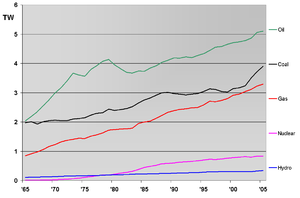 World consumption of primary energy by energy type in terawatts (TW), 1965-2005.[133]
World consumption of primary energy by energy type in terawatts (TW), 1965-2005.[133]
In the past, the price of oil has led to economic recessions, such as the 1973 and 1979 energy crises. The effect the price of oil has on an economy is known as a price shock. In many European countries, which have high taxes on fuels, such price shocks could potentially be mitigated somewhat by temporarily or permanently suspending the taxes as fuel costs rise.[134] This method of softening price shocks is less useful in countries with much lower gas taxes, such as the United States.
Some economists predict that a substitution effect will spur demand for alternate energy sources, such as coal or liquefied natural gas. This substitution can only be temporary, as coal and natural gas are finite resources as well.
Prior to the run-up in fuel prices, many motorists opted for larger, less fuel-efficient sport utility vehicles and full-sized pickups in the United States, Canada, and other countries. This trend has been reversing due to sustained high prices of fuel. The September 2005 sales data for all vehicle vendors indicated SUV sales dropped while small cars sales increased. Hybrid and diesel vehicles are also gaining in popularity.[135]
In 2008, a report by Cambridge Energy Research Associates stated that 2007 had been the year of peak gasoline usage in the United States, and that record energy prices would cause an "enduring shift" in energy consumption practices.[136] According to the report, in April gas consumption had been lower than a year before for the sixth straight month, suggesting 2008 would be the first year U.S. gasoline usage declined in 17 years. The total miles driven in the U.S. peaked in 2006.[137]
The Export Land Model states that after peak oil petroleum exporting countries will be forced to reduce their exports more quickly than their production decreases because of internal demand growth. Countries that rely on imported petroleum will therefore be affected earlier and more dramatically than exporting countries.[138] Mexico is already in this situation. Internal consumption grew by 5.9% in 2006 in the five biggest exporting countries, and their exports declined by over 3%. It was estimated that by 2010 internal demand would decrease worldwide exports by 2,500,000 barrels per day (400,000 m3/d).[139]
Canadian economist Jeff Rubin has stated that high oil prices will likely result in increased consumption in developed countries through partial manufacturing de-globalisation of trade. Manufacturing production would move closer to the end consumer to minimise transportation network costs, and therefore a demand decoupling from Gross Domestic Product would occur. Higher oil prices would lead to increased freighting costs and consequently, the manufacturing industry would move back to the developed countries since freight costs would outweigh the current economic wage advantage of developing countries.[140][141]
Economic research carried out by the International Monetary Fund puts overall price elasticity of demand for oil at -0.025 short term and -0.093 long term. [142]
Long-term effects on lifestyle
A majority of Americans live in suburbs, a type of low-density settlement designed around universal personal automobile use. Commentators such as James Howard Kunstler argue that because over 90% of transportation in the U.S. relies on oil, the suburbs' reliance on the automobile is an unsustainable living arrangement. Peak oil would leave many Americans unable to afford petroleum based fuel for their cars, and force them to use bicycles or electric vehicles. Additional options include telecommuting, moving to rural areas, or moving to higher density areas, where walking and public transportation are more viable options. In the latter two cases, suburbia may become the "slums of the future."[143][144] The issues of petroleum supply and demand is also a concern for growing cities in developing countries (where urban areas are expected to absorb most of the world's projected 2.3 billion population increase by 2050). Stressing the energy component of future development plans is seen as an important goal.[145]
Methods that have been suggested[146] for mitigating these urban and suburban issues include the use of non-petroleum vehicles such as electric cars, battery electric vehicles, transit-oriented development, Car-free Cities, bicycles, new trains, new pedestrianism, smart growth, shared space, urban consolidation, urban villages, and New Urbanism.
An extensive 2009 report by the United States National Research Council of the Academy of Sciences, commissioned by the United States Congress, stated six main findings.[147] First, that compact development is likely to reduce "Vehicle Miles Traveled" (VMT) throughout the country. Second, that doubling residential density in a given area could reduce VMT by as much as 25% if coupled with measures such as increased employment density and improved public transportation. Third, that higher density, mixed-use developments would produce both direct reductions in CO2 emissions (from less driving), and indirect reductions (such as from lower amounts of materials used per housing unit, higher efficiency climate control, longer vehicle lifespans, and higher efficiency delivery of goods and services). Fourth, that although short term reductions in energy use and CO2 emissions would be modest, that these reductions would grow over time. Fifth, that a major obstacle to more compact development in the United States is political resistance from local zoning regulators, which would hamper efforts by state and regional governments to participate in land-use planning. Sixth, the committee agreed that changes in development that would alter driving patterns and building efficiency would have various secondary costs and benefits that are difficult to quantify. The report recommends that policies supporting compact development (and especially its ability to reduce driving, energy use, and CO2 emissions) should be encouraged.
An economic theory that has been proposed as a remedy is the introduction of a steady state economy. Such a system would include a tax shifting from income to depleting natural resources (and pollution), as well as the limitation of advertising that stimulates demand and population growth. It also includes the institution of policies that move away from globalization and toward localization to conserve energy resources, provide local jobs, and maintain local decision-making authority. Zoning policies would be adjusted to promote resource conservation and eliminate sprawl.[148][149]
Mitigation
Main article: Mitigation of peak oilTo avoid the serious social and economic implications a global decline in oil production could entail, the 2005 Hirsch report emphasized the need to find alternatives, at least ten to twenty years before the peak, and to phase out the use of petroleum over that time.[150] This was similar to a plan proposed for Sweden that same year. Such mitigation could include energy conservation, fuel substitution, and the use of unconventional oil. Because mitigation can reduce the use of traditional petroleum sources, it can also affect the timing of peak oil and the shape of the Hubbert curve.
Positive aspects of peak oil
Some observers opine that peak oil should be viewed as a positive event.[151] Many such critics reason that if the price of oil rises high enough, the use of alternative clean fuels could help control pollution from fossil fuel use, and mitigate global warming.[152] Permaculture, particularly as expressed in the work of Australian David Holmgren, and others, sees peak oil as holding tremendous potential for positive change, assuming countries act with foresight. The rebuilding of local food networks, energy production, and the general implementation of 'energy descent culture' are argued to be ethical responses to the acknowledgment of finite fossil resources.[153]
The Transition Towns movement, started in Totnes, Devon[154] and spread internationally by "The Transition Handbook" (Rob Hopkins), sees the restructuring of society for more local resilience and ecological stewardship as a natural response to the combination of peak oil and climate change.[155]
Criticisms
Some do not agree with peak oil, at least as it has been presented by Matthew Simmons. The president of Royal Dutch Shell's U.S. operations John Hofmeister, while agreeing that conventional oil production will soon start to decline, has criticized Simmons's analysis for being "overly focused on a single country: Saudi Arabia, the world's largest exporter and OPEC swing producer." He also points to the large reserves at the U.S. outer continental shelf, which holds an estimated 100 billion barrels (16×109 m3) of oil and natural gas. As things stand, however, only 15% of those reserves are currently exploitable, a good part of that off the coasts of Louisiana, Alabama, Mississippi, and Texas. Hofmeister also contends that Simmons erred in excluding unconventional sources of oil such as the oil sands of Canada, where Shell is already active. The Canadian oil sands—a natural combination of sand, water, and oil found largely in Alberta and Saskatchewan—is believed to contain one trillion barrels of oil. Another trillion barrels are also said to be trapped in rocks in Colorado, Utah, and Wyoming,[156] but are in the form of oil shale. These particular reserves present major environmental, social, and economic obstacles to recovery.[157][158] Hofmeister also claims that if oil companies were allowed to drill more in the United States enough to produce another 2 million barrels per day (320×103 m3/d), oil and gas prices would not be as high as they are in the later part of the 2000 to 2010 decade. He thinks that high energy prices are causing social unrest similar to levels surrounding the Rodney King riots.[159]
Dr. Christoph Rühl, chief economist of BP, repeatedly uttered strong doubts about the peak oil hypothesis:[160]
Physical peak oil, which I have no reason to accept as a valid statement either on theoretical, scientific or ideological grounds, would be insensitive to prices. (...)In fact the whole hypothesis of peak oil – which is that there is a certain amount of oil in the ground, consumed at a certain rate, and then it's finished – does not react to anything.... (Global Warming) is likely to be more of a natural limit than all these peak oil theories combined. (...) Peak oil has been predicted for 150 years. It has never happened, and it will stay this way.
According to Rühl, the main limitations for oil availability are "above ground" and are to be found in the availability of staff, expertise, technology, investment security, money and last but not least in global warming. The oil question is about price and not the basic availability. His views are shared by Daniel Yergin of CERA, who added that the recent high price phase might add to a future demise of the oil industry - not of lack of resources or an apocalyptic shock but the timely and smooth setup of alternatives.[161]
Clive Mather, CEO of Shell Canada, said the Earth's supply of hydrocarbons is almost infinite, referring to hydrocarbons in oil sands.[162] Engineer Peter Huber believes the Canadian oil sands can fuel all of humanity's needs for over 100 years.[162]
Industry blogger Steve Maley echoed some of the points of Yergin, Rühl, Mather and Hofmeister.[163]
See also
Prediction
- Ecoflation
- Hirsch report
- Hubbert Linearization
- Limits to Growth
- Malthusian catastrophe
- Oil depletion
- Oil Storm
- Olduvai theory
- World energy resources and consumption
Energy policy
Economics
- Ecological economics
- Efficient energy use
- Gross domestic product per barrel
- Kuznets curve
- List of countries by proven oil reserves
- List of oil-consuming states
- Low-carbon economy
- Oil burden
- Oil price increases since 2003
- Steady state economics
- 2000s commodities boom
Others
Further information
Books
- Campbell, Colin J (2004). The Essence of Oil & Gas Depletion. Multi-Science Publishing. ISBN 0-906522-19-6.
- Campbell, Colin J (1997). The Coming Oil Crisis. Multi-Science Publishing. ISBN 0-906522-11-0.
- Campbell, Colin J (2005). Oil Crisis. Multi-Science Publishing. ISBN 0-906522-39-0.
- Deffeyes, Kenneth S (2002). Hubbert's Peak: The Impending World Oil Shortage. Princeton University Press. ISBN 0-691-09086-6.
- Deffeyes, Kenneth S (2005). Beyond Oil: The View from Hubbert's Peak. Hill and Wang. ISBN 0-8090-2956-1.
- Goodstein David (2005). Out of Gas: The End of the Age Of Oil. WW Norton. ISBN 0-393-05857-3.
- Heinberg Richard (2003). The Party's Over: Oil, War, and the Fate of Industrial Societies. New Society Publishers. ISBN 0-86571-482-7.
- Heinberg, Richard (2004). Power Down: Options and Actions for a Post-Carbon World. New Society Publishers. ISBN 0-86571-510-6.
- Heinberg, Richard (2006). The Oil Depletion Protocol: A Plan to Avert Oil Wars, Terrorism and Economic Collapse. New Society Publishers. ISBN 0-86571-563-7.
- Huber Peter (2005). The Bottomless Well. Basic Books. ISBN 0-465-03116-1.
- Kunstler James H (2005). The Long Emergency: Surviving the End of the Oil Age, Climate Change, and Other Converging Catastrophes. Atlantic Monthly Press. ISBN 0-87113-888-3.
- Leggett Jeremy K (2005). The Empty Tank: Oil, Gas, Hot Air, and the Coming Financial Catastrophe. Random House. ISBN 1-4000-6527-5.
- Leggett, Jeremy K (2005). Half Gone: Oil, Gas, Hot Air and the Global Energy Crisis. Portobello Books. ISBN 1-8462-7004-9.
- Leggett Jeremy K (2001). The Carbon War: Global Warming and the End of the Oil Era. Routledge. ISBN 0415931029.
- Lovins Amory et al. (2005). Winning the Oil Endgame: Innovation for Profit, Jobs and Security. Rocky Mountain Institute. ISBN 1-881071-10-3.
- Pfeiffer Dale Allen (2004). The End of the Oil Age. Lulu Press. ISBN 1-4116-0629-9.
- Newman Sheila (2008). The Final Energy Crisis (2nd ed.). Pluto Press. ISBN 978-0-7453-2717-4. OCLC 228370383.
- Roberts Paul (2004). The End of Oil. On the Edge of a Perilous New World. Boston: Houghton Mifflin. ISBN 9780618239771.
- Ruppert Michael C (2005). Crossing the Rubicon: The Decline of the American Empire at the End of the Age of Oil. New Society. ISBN 978-0865715400.
- Simmons Matthew R (2005). Twilight in the Desert: The Coming Saudi Oil Shock and the World Economy. Hoboken, N.J.: Wiley & Sons. ISBN 0-471-73876-X.
- Simon Julian L (1998). The Ultimate Resource. Princeton University Press. ISBN 0-691-00381-5.
- Stansberry Mark A, Reimbold Jason (2008). The Braking Point. Hawk Publishing. ISBN 978-1-930709-67-6.
- Tertzakian Peter (2006). A Thousand Barrels a Second. McGraw-Hill. ISBN 0-07-146874-9.
Articles
- Tinker Scott W (2005-06-25). "Of peaks and valleys: Doomsday energy scenarios burn away under scrutiny". Dallas Morning News. http://www.jsg.utexas.edu/news/rels/062505a.html.
- Benner Katie (2005-12-07). "Lawmakers: Will we run out of oil?". CNN. http://money.cnn.com/2005/12/07/markets/peak_oil/index.htm.
- Benner Katie (2004-11-03). "Oil: Is the end at hand?". CNN. http://money.cnn.com/2004/11/02/markets/peak_oil/.
- "The future of oil". Foreign Policy. http://www.foreignpolicy.com/story/cms.php?story_id=3233.
- Robert Hirsch (2008-06). "Peak oil: "A significant period of discomfort"". Allianz Knowledge. http://knowledge.allianz.com/en/globalissues/safety_security/energy_security/hirsch_peak_oil_production.html.[dead link]
- Didier Houssin, International Energy Agency (2008-05). "Oil: "If you invest more, you find more"". Allianz Knowledge. http://knowledge.allianz.com/en/globalissues/safety_security/energy_security/iea_energy_houssin.html.[dead link]
- Campbell Colin, Laherrère Jean. "The end of cheap oil". Scientific American. http://dieoff.org/page140.htm.
- Williams Mark. "The end of oil?". Technology Review (MIT). http://www.technologyreview.com/articles/05/02/issue/review_oil.asp.
- Appenzeller Tim. "The end of cheap oil". National Geographic. http://ngm.nationalgeographic.com/ngm/0406/feature5/.
- Lynch Michael C. "The new pessimism about petroleum resources". http://www.gasresources.net/Lynch(Hubbert-Deffeyes).htm.
- Leonardo Maugeri (2004-05-20). "Oil: Never Cry Wolf—Why the Petroleum Age Is Far from over". Science. http://www.energybulletin.net/node/347.
- Roberts Paul (2004-08). "Last Stop Gas". Harper's Magazine: 71–72. http://www.harpers.org/LastStopGas.html.
- Porter, Adam (2005-06-10). "'Peak oil' enters mainstream debate". BBC News. http://news.bbc.co.uk/1/hi/business/4077802.stm. Retrieved 2010-03-26.
- Alex Kuhlman (2006-06). "Peak oil and the collapse of commercial aviation" (PDF). Airways. http://www.oildecline.com/airways.pdf.
- Cochrane Troy (2008-01-04). "Peak oil?: Oil supply and accumulation". Cultural Shifts. http://culturalshifts.com/archives/205.
- Jaeon Kirby & Colin Campbell (2008-05-30). "Life at $200 a barrel". Maclean's. http://www.macleans.ca/business/economy/article.jsp?content=20080528_21002_21002.
- Stefan Schaller (2010-09-28). "The Theory behind Peak Oil". http://stefan-schaller.com/2010/09/28/the-theory-behind-peak-oil.
- Ariel Schwartz (2011-02-09). "WikiLeaks May Have Just Confirmed That Peak Oil Is Imminent". Fast Company. http://www.fastcompany.com/1725372/wikileaks-may-have-just-confirmed-the-existence-of-peak-oil.
- D. de San Miguel (2011-08-01). "Oil Supply Analysis". Balance of Planet. http://www.balanceofplanet.com/news/na_110801_0001.htm.
Documentary films
- The End of Suburbia: Oil Depletion and the Collapse of the American Dream (2004)
- Crude Awakening: The Oil Crash (2006)
- The Power of Community: How Cuba Survived Peak Oil (2006)
- Crude Impact (2006)
- What a Way to Go: Life at the End of Empire (2007)
- PetroApocalypse Now? (2008)
- Collapse (2009)
Notes
- ^ A list of over 20 published articles and books from government and journal sources supporting this thesis have been compiled at Dieoff.org in the section "Food, Land, Water, and Population."
References
- ^ Hubbert, Marion King (June 1956). "Nuclear Energy and the Fossil Fuels 'Drilling and Production Practice'" (PDF). Spring Meeting of the Southern District. Division of Production. American Petroleum Institute. San Antonio, Texas: Shell Development Company. pp. 22–27. http://www.hubbertpeak.com/hubbert/1956/1956.pdf. Retrieved 2008-04-18.
- ^ Brandt, Adam R. (May 2007). "Testing Hubbert" (PDF). Energy Policy (Elsevier) 35 (5): 3074–3088. doi:10.1016/j.enpol.2006.11.004. http://www.iaee.org/en/students/best_papers/Adam_Brandt.pdf.
- ^ "CERA says peak oil theory is faulty". Energy Bulletin (Cambridge Energy Research Associates (CERA)). 2006-11-14. Archived from the original on 2008-06-22. http://web.archive.org/web/20080622222111/http://www.energybulletin.net/22381.html. Retrieved 2008-07-27.
- ^ a b c Deffeyes, Kenneth S (2007-01-19). "Current Events - Join us as we watch the crisis unfolding". Princeton University: Beyond Oil. http://www.princeton.edu/hubbert/current-events.html. Retrieved 2008-07-27.
- ^ a b c d e f g Zittel, Werner; Schindler, Jorg (October 2007) (PDF). Crude Oil: The Supply Outlook. Energy Watch Group. EWG-Series No 3/2007. http://www.energywatchgroup.org/fileadmin/global/pdf/EWG_Oilreport_10-2007.pdf. Retrieved 2008-07-27.
- ^ a b c d e Cohen, Dave (2007-10-31). "The Perfect Storm". Association for the Study of Peak Oil and Gas. http://www.aspo-usa.com/archives/index.php?option=com_content&task=view&id=243&Itemid=91. Retrieved 2008-07-27.
- ^ a b Kjell Aleklett, Mikael Höök, Kristofer Jakobsson, Michael Lardelli, Simon Snowden, Bengt Söderbergh (2009-11-09). "The Peak of the Oil Age". Energy Policy. http://www.tsl.uu.se/uhdsg/Publications/PeakOilAge.pdf. Retrieved 2009-11-15.
- ^ a b c Koppelaar, Rembrandt H.E.M. (September 2006) (PDF). World Production and Peaking Outlook. Peakoil Nederland. http://peakoil.nl/wp-content/uploads/2006/09/asponl_2005_report.pdf. Retrieved 2008-07-27.
- ^ a b c Nick A. Owen, Oliver R. Inderwildi, David A. King (2010). "The status of conventional world oil reserves—Hype or cause for concern?". Energy Policy 38 (8): 4743. doi:10.1016/j.enpol.2010.02.026.
- ^ Plumer, Brad (2011-10-06). "Why is it so tricky to define ‘peak oil’?". Washington Post. http://www.washingtonpost.com/blogs/ezra-klein/post/defining-peak-oil/2011/10/06/gIQABuLgQL_blog.html. Retrieved 2011-11-04.
- ^ http://www.babelation.com/feed/iea-reports-world-oil-supply-rose-alltime-high-89-million-barrels-day-february-2011
- ^ "Is ‘Peak Oil’ Behind Us?". The New York Times. November 14, 2010
- ^ "Has the World Already Passed “Peak Oil”? ". National Geographic News. November 9, 2010
- ^ a b Bruno, Joe Bel (2008-03-08). "Oil Rally May Be Economy's Undoing". USA Today. Associated Press. http://www.usatoday.com/money/economy/2008-03-08-3190491488_x.htm. Retrieved 2009-07-11.
- ^ BP, Statistical Review of World Energy 2010
- ^ "World oil demand 'to rise by 37%'". BBC News. 2006-06-20. http://news.bbc.co.uk/2/hi/business/5099400.stm. Retrieved 2008-08-25.
- ^ "Petroleum and other liquid fuels" (PDF). 2007 International Energy Outlook. United States Energy Information Administration. May 2007. http://www.eia.doe.gov/oiaf/archive/ieo07/pdf/oil.pdf. Retrieved 2009-07-11.
- ^ International Energy Outlook 2009
- ^ (PDF) Annual Energy Review 2008. United States Energy Information Administration. 2009-06-29. DOE/EIA-0384(2008). http://www.eia.doe.gov/emeu/aer/pdf/pages/sec1_3.pdf. Retrieved 2009-07-11.
- ^ a b "Global Oil Consumption". United States Energy Information Administration. http://www.eia.doe.gov/pub/oil_gas/petroleum/analysis_publications/oil_market_basics/demand_text.htm#Global%20Oil%20Consumption. Retrieved 2008-07-27.
- ^ Wood, John H.; Long, Gary R.; Morehouse, David F. (2004-08-18). "Long-Term World Oil Supply Scenarios: The Future Is Neither as Bleak or Rosy as Some Assert". United States Energy Information Administration. http://www.eia.doe.gov/pub/oil_gas/petroleum/feature_articles/2004/worldoilsupply/oilsupply04.html. Retrieved 2008-07-27.
- ^ "Domestic Demand for Refined Petroleum Products by Sector". United States Bureau of Transportation Statistics. http://www.bts.gov/publications/national_transportation_statistics/html/table_04_03.html. Retrieved 2007-12-20.
- ^ a b "International Petroleum (Oil) Consumption Data". United States Energy Information Administration. http://www.eia.doe.gov/emeu/international/oilconsumption.html. Retrieved 2007-12-20.
- ^ a b (PDF) BP Statistical Review of Energy. BP. June 2008. http://www.bp.com/liveassets/bp_internet/globalbp/globalbp_uk_english/reports_and_publications/statistical_energy_review_2008/STAGING/local_assets/downloads/pdf/statistical_review_of_world_energy_full_review_2008.pdf. Retrieved 2008-07-27.
- ^ "Oil price 'may hit $200 a barrel'". BBC News. 2008-05-07. http://news.bbc.co.uk/2/hi/business/7387203.stm. Retrieved 2009-07-11.
- ^ Mcdonald, Joe (2008-04-21). "Gas guzzlers a hit in China, where car sales are booming". USA Today. Associated Press. http://www.usatoday.com/money/economy/2008-04-21-2494500625_x.htm. Retrieved 2009-07-11.
- ^ O'Brien, Kevin (2008-07-02). "China's Negative Economic Outlook". Seeking Alpha. http://seekingalpha.com/article/83459-china-s-negative-economic-outlook. Retrieved 2008-07-27.
- ^ "China and India: A Rage for Oil". Business Week. 2005-08-25. http://www.businessweek.com/bwdaily/dnflash/aug2005/nf20050825_4692_db016.htm?chan=gb. Retrieved 2008-07-27.
- ^ Goldstein, Steve (2009-01-26). "IEA sees first two-year oil demand fall in 26 years". The Wall Street Journal. http://www.marketwatch.com/news/story/iea-forecasts-first-two-year-oil/story.aspx?guid={046FC369-8971-4669-A3E2-F94414A8DA60}. Retrieved 2009-07-11.
- ^ Gold, Russell; Campoy, Ana (2009-04-13). "Oil Industry Braces for Drop in U.S. Thirst for Gasoline". The Wall Street Journal. http://online.wsj.com/article/SB123957686061311925.html. Retrieved 2009-04-21.
- ^ Associated Press (21 December 2010). "US Gas Demand on Long-Term Decline After Hitting ’06 Peak". Jakarta Globe. http://www.thejakartaglobe.com/naturalresources/us-gas-demand-on-long-term-decline-after-hitting-06-peak/412956. Retrieved 10 January 2011.
- ^ Alexander Kwiatkowski (2010-02-11). "IEA Raises 2010 Oil Demand Estimate on Recovery, Asia". Bloomberg News.
- ^ Baizhen Chua (2010-02-04). "China May Renew Record for Crude Oil Imports in 2010". Bloomberg.com.
- ^ a b Duncan, Richard C (November 2001). "The Peak of World Oil Production and the Road to the Olduvai Gorge". Population and Environment (Springer Netherlands) 22 (5): 503–522. doi:10.1023/A:1010793021451. ISSN 1573-7810. http://dieoff.org/page224.htm. Retrieved 2009-07-11.
- ^ a b c d e Total Midyear Population for the World: 1950-2050. United States Census Bureau. 2008-06-18. http://www.census.gov/compendia/statab/tables/09s1285.xls. Retrieved 2007-12-20.[dead link]
- ^ Savinar, Matt. "Are We 'Running Out'? I Thought There Was 40 Years of the Stuff Left". Life After the Oil Crash. http://www.lifeaftertheoilcrash.net/. Retrieved 2007-12-20.
- ^ Mieszkowski, Katharine (2006-03-22). "The oil is going, the oil is going!". Salon.com (Salon Media Group). http://www.salon.com/news/feature/2006/03/22/peakoil/. Retrieved 2008-03-08.
- ^ Bartlett, Albert A. (2004-08-27). "Thoughts on Long-Term Energy Supplies: Scientists and the Silent Lie" (PDF). Physics Today (American Institute of Physics) 57 (7): 53–57. ISSN 0031-9228. http://fire.pppl.gov/energy_population_pt_0704.pdf. Retrieved 2008-03-08.
- ^ a b c d "International Petroleum (Oil) Production Data". United States Energy Information Administration. http://www.eia.doe.gov/emeu/international/oilproduction.html. Retrieved 2008-03-31.
- ^ "The World Factbook". United States Central Intelligence Agency. 2008-03-20. https://www.cia.gov/library/publications/the-world-factbook/geos/xx.html. Retrieved 2008-03-31.
- ^ "Table of World Oil Production 2006" (PDF). BP Statistical Review of Energy. BP. June 2006. http://www.bp.com/liveassets/bp_internet/globalbp/globalbp_uk_english/reports_and_publications/statistical_energy_review_2006/STAGING/local_assets/downloads/pdf/table_of_world_oil_production_2006.pdf. Retrieved 2007-12-20.
- ^ Goodchild, Peter (2007-10-29). "Peak Oil And Famine:Four Billion Deaths". Countercurrents. http://www.countercurrents.org/goodchild291007.htm. Retrieved 2008-08-21.
- ^ Pfeiffer, Dale Allen (2004). "Eating Fossil Fuels". From The Wilderness Publications. http://www.fromthewilderness.com/free/ww3/100303_eating_oil.html. Retrieved 2008-08-21.
- ^ P. Crabbè, North Atlantic Treaty Organization. Scientific Affairs Division (2000). "Implementing ecological integrity: restoring regional and global environmental and human health". Springer. p.411. ISBN 0792363515
- ^ Bradley, David (2004-02-06) (PDF). A Great Potential: The Great Lakes as a Regional Renewable Energy Source. Buffalo's Green Gold Development Corporation. http://greengold.org/wind/documents/107.pdf. Retrieved 2008-10-04.[dead link]
- ^ Hirsch, Tim (2001-12-24). "Iceland launches energy revolution". BBC News. http://news.bbc.co.uk/2/hi/science/nature/1727312.stm. Retrieved 2008-03-23.
- ^ a b c Donnelly, John (2005-12-11). "Price rise and new deep-water technology opened up offshore drilling". The Boston Globe. http://www.boston.com/news/world/articles/2005/12/11/price_rise_and_new_deep_water_technology_opened_up_offshore_drilling/. Retrieved 2008-08-21.
- ^ "The Next Crisis: Prepare for Peak Oil". The Wall Street Journal. February 11, 2010.
- ^ Campbell, C. J. (December 2000). "Peak Oil Presentation at the Technical University of Clausthal". energycrisis.org. http://energycrisis.org/de/lecture.html. Retrieved 2008-08-21.
- ^ Longwell, Harry J. (2002). "The Future of the Oil and Gas Industry: Past Approaches, New Challenges" (PDF). World Energy Magazine (Loomis Publishing Services) 5 (3): 100–104. http://www.worldenergysource.com/articles/pdf/longwell_WE_v5n3.pdf. Retrieved 2008-08-21.
- ^ (PDF) The General Depletion Picture. Ireland: Association for the Study of Peak Oil and Gas. 2007. p. 2. Archived from the original on 2009-11-28. http://www.webcitation.org/5ldESvbCm. Retrieved 2008-08-21.
- ^ Christopher Johnson (2010-02-11). "Oil exploration costs rocket as risks rise". Reuters. http://www.reuters.com/article/idUSTRE61A28X20100211. Retrieved 2010-09-09.
- ^ Webber, John (2007-9). "UK Oil Reserves and Estimated Ultimate Recovery 2007". Department of Energy and Climate Change. https://www.og.decc.gov.uk/information/bb_updates/chapters/Table4_3.htm. Retrieved 2009-07-11.
- ^ Herbert, Jozef (2007-07-16). "Oil industry report says demand to outpace crude oil production". Associated Press. BLNZ. http://www.blnz.com/news/2007/07/16/Study_Demand_outpace_crude_supply_pply.html. Retrieved 2009-07-11.
- ^ a b c d e Maass Peter (2005-08-21). "The Breaking Point". New York Times. http://www.nytimes.com/2005/08/21/magazine/21OIL.html. Retrieved 2008-08-26.
- ^ "Briefing: Exxon increases budget for oil exploration". International Herald Tribune. 2007-03-07. http://www.nytimes.com/2007/03/07/business/worldbusiness/07iht-ibrief.4834735.html. Retrieved 2008-08-26.
- ^ "Shell plans huge spending increase". International Herald Tribune. 2005-12-14. http://www.nytimes.com/2005/12/14/business/worldbusiness/14iht-shell.html. Retrieved 2008-08-26.
- ^ Boxell, James (2004-10-10). "Top Oil Groups Fail to Recoup Exploration". The New York Times (Energy Bulletin). Archived from the original on 2008-05-21. http://web.archive.org/web/20080521144405/http://www.energybulletin.net/2470.html. Retrieved 2008-08-26.
- ^ Gerth, Jeff (2004-02-24). "Forecast of Rising Oil Demand Challenges Tired Saudi Fields". The New York Times. Archived from the original on 2008-03-09. http://web.archive.org/web/20080309103717/http://www.nytimes.com/2004/02/24/business/24OIL.html. Retrieved 2008-08-26.
- ^ Morsfeld, Carl (2004-10-10). "How Shell blew a hole in a 100-year reputation". London: The Times. http://business.timesonline.co.uk/tol/business/article991863.ece. Retrieved 2008-08-26.
- ^ Darwish, Badrya (2008-06-16). "What lies beneath?". Kuwait Times. http://www.kuwaittimes.net/read_news.php?newsid=MjM0ODI5MzU=. Retrieved 2008-08-26.
- ^ Javed, Ali (2000-12-01). "The Economic and Environmental Impact of the Gulf War on Kuwait and the Persian Gulf". American University Trade and Environment Database. http://www.american.edu/TED/kuwait.htm. Retrieved 2007-11-18.
- ^ Palast, Greg (2006-05-23). "No Peaking: The Hubbert Humbug". Guerrilla News Network. http://www.gregpalast.com/madhouse/index.php/32. Retrieved 2010-07-14.
- ^ Heinberg, Richard (July 2006). "An Open Letter to Greg Palast on Peak Oil". http://heinberg.wordpress.com/2006/07/01/171-an-open-letter-to-greg-palast-on-peak-oil/. Retrieved 2010-07-14.
- ^ a b Learsy, Raymond J. (2003-12-04). "OPEC Follies - Breaking point". National Review. http://www.nationalreview.com/comment/learsy200312040900.asp. Retrieved 2008-08-26.
- ^ a b Macalister, Terry (2009-11-10). "Whistleblower: key oil figures were distorted by US pressure". The Guardian (London): pp. 1–2. http://www.guardian.co.uk/environment/2009/nov/09/peak-oil-international-energy-agency. Retrieved 2009-11-11.
- ^ "Modernization of Oil and Gas Reporting". Rule changes. SEC. January 1, 2010 (effective). http://www.sec.gov/rules/final/2008/33-8995.pdf. Retrieved March 29, 2010.
- ^ a b Bob Weber. "Alberta's oilsands: well-managed necessity or ecological disaster?". Moose Jaw Herald, The Canadian Press. http://www.mjtimes.sk.ca/Canada---World/Business/2009-12-10/article-243834/Albertas-oilsands:-well-managed-necessity-or-ecological-disaster%3F/1. Retrieved March 29, 2010.
- ^ Duarte, Joe (2006-03-28). "Canadian Tar Sands: The Good, the Bad, and the Ugly". RigZone. http://www.rigzone.com/news/article.asp?a_id=30703. Retrieved 2009-07-11.
- ^ "Environmental Challenges of Heavy Crude Oils". Battelle Memorial Institute. 2003. http://www.battelle.org/Environment/publications/envupdates/Fall2003/article9.stm. Retrieved 2009-07-11.
- ^ Sexton, Matt (2003). "Tar Sands: A brief overview". http://ffden-2.phys.uaf.edu/102spring2002_Web_projects/M.Sexton/. Retrieved 2009-07-11.
- ^ Dyni, John R. (2003). "Geology and resources of some world oil-shale deposits (Presented at Symposium on Oil Shale in Tallinn, Estonia, November 18–21, 2002)" (PDF). Oil Shale. A Scientific-Technical Journal (Estonian Academy Publishers) 20 (3): 193–252. ISSN 0208-189X. http://www.kirj.ee/public/oilshale/2_dyni_2003_3.pdf. Retrieved 2007-06-17.
- ^ Johnson, Harry R.; Crawford, Peter M.; Bunger, James W. (2004) (PDF). Strategic significance of America's oil shale resource. Volume II: Oil shale resources, technology and economics. Office of Deputy Assistant Secretary for Petroleum Reserves; Office of Naval Petroleum and Oil Shale Reserves; United States Department of Energy. http://www.fossil.energy.gov/programs/reserves/npr/publications/npr_strategic_significancev2.pdf. Retrieved 2007-06-23.
- ^ Evans, Jon. "Sand banks: If unconventional sources of oil, such as oil sands, could be transformed into crude we could still have a 300-year supply left. The problem is extracting it." Chemistry and Industry 6 November 2006: 18-36. Gale Gerneral OneFile. Web. 5 October 2009. <http://find.galegroup.com>.
- ^ Kovarik, Bill. "The oil reserve fallacy: Proven reserves are not a measure of future supply". http://www.runet.edu/~wkovarik/oil/3unconventional.html. Retrieved 2009-07-11.
- ^ Dusseault, Maurice (2002) (PDF). Emerging Technology for Economic Heavy Oil Development. Alberta Department of Energy. http://www.energy.gov.ab.ca/OilSands/pdfs/RPT_Chops_app2.pdf. Retrieved 2008-05-24.
- ^ "An Estimate of Recoverable Heavy Oil Resources of the Orinoco Oil Belt, Venezuela". USGS. 11 January 2010. http://pubs.usgs.gov/fs/2009/3028/pdf/FS09-3028.pdf. Retrieved 23 January 2010.
- ^ Alboudwarej, Hussein; et al (Summer 2006). "Highlighting Heavy Oil" (PDF). Oilfield Review (Schlumberger). http://www.slb.com/media/services/resources/oilfieldreview/ors06/sum06/heavy_oil.pdf. Retrieved 2008-05-24.
- ^ Wood, Tim (2005-11-05). "Oil Doomsday is Nigh, Tar Sands Not a Substitute". Resource Investor. http://www.resourceinvestor.com/News/2005/5/Pages/Oil-Doomsday-is-Nigh--Tar-Sands-Not-a-Substitute.aspx. Retrieved 2009-07-11.
- ^ Söderbergh, B.; Robelius, F.; Aleklett, K. (2007). "A crash programme scenario for the Canadian oil sands industry" (PDF). Energy Policy (Elsevier) 35 (3): 1931–1947. doi:10.1016/j.enpol.2006.06.007. http://www.tsl.uu.se/uhdsg/Publications/Tarsandsarticle.pdf. Retrieved 2008-06-17.
- ^ Weissman, Jeffrey G.; Kessler, Richard V. (1996-06-20). "Downhole heavy crude oil hydroprocessing". Applied Catalysis A: General 140 (1): 1–16. doi:10.1016/0926-860X(96)00003-8. ISSN 0926-860X.
- ^ Fleming, David (2000). After Oil. Prospect Magazine. http://www.prospectmagazine.co.uk/2000/11/afteroil/. Retrieved 2009-12-20.
- ^ Hoyos, Carola (2007-02-18). "Study sees harmful hunt for extra oil". Financial Times. http://www.ft.com/cms/s/0/11ba213e-bf7e-11db-9ac2-000b5df10621.html. Retrieved 2009-07-11.
- ^ Lemley Brad (2003-05-01). "Anything Into Oil". Discover magazine. http://discovermagazine.com/2003/may/featoil/. Retrieved 2009-07-11.
- ^ Lemley Brad (2006-04-02). "Anything Into Oil". Discover magazine. http://discovermagazine.com/2006/apr/anything-oil/. Retrieved 2009-07-11.
- ^ Green Freedom: A Concept for Producing Carbon Neutral Synthetic Fuels and Chemicals, Los Alamos National Laboratory, by F. Jeffrey Martin and William L. Kubic, 2007
- ^ Mackey, Peg; Lawler, Alex (2008-01-09). "Tough to pump more oil, even at $100". Reuters. http://www.reuters.com/article/ousiv/idUSL0725705620080109?sp=true. Retrieved 2009-07-11.
- ^ Kailing, Timothy D (2008-12-14). "Can the United States Drill Its Way to Energy Security?". Journal of Energy Security (Institute for the Analysis of Global Security). http://www.ensec.org/index.php?option=com_content&view=article&id=166:can-us-drill-its-way-to-energy-security&catid=90:energysecuritydecember08&Itemid=334/. Retrieved 2009-07-11.
- ^ a b (PDF) World oil supply and demand. International Energy Agency. 2007-01-18. http://omrpublic.iea.org/omrarchive/18jan07tab.pdf. Retrieved 2009-07-28.
- ^ Monbiot, George (2008-12-15). "When will the oil run out?". London: The Guardian. http://www.guardian.co.uk/business/2008/dec/15/oil-peak-energy-iea. Retrieved 2009-07-28.
- ^ "Peak Oil and Energy Resources". Workers Solidarity Movement. 2006-06-23. http://wsm.ie/story/1006. Retrieved 2009-07-28.
- ^ "Country Analysis Briefs: Saudi Arabia". United States Energy Information Administration. August 2008. http://classic-web.archive.org/web/20070412143230/http://www.eia.doe.gov/cabs/saudi.html. Retrieved 2008-09-04.
- ^ Miller, Matthew S (2007-03-09). "Ghawar is dead!". Energy Bulletin. http://energybulletin.net/node/27024. Retrieved 2009-07-28.
- ^ Cordahi, James; Critchlow, Andy (2005-11-09). "Kuwait oil field, world's second largest, 'Exhausted'". Bloomberg. http://energybulletin.net/node/10878. Retrieved 2009-07-28.
- ^ "New Energy Realities - WEO Calls for Global Energy Revolution Despite Economic Crisis". IEA Press Release. International Energy Agency. 12 November 2008. http://www.iea.org/textbase/press/pressdetail.asp?PRESS_REL_ID=275. Retrieved 2009-08-04.
- ^ Mortishead, Carl (2008-01-18). "World not running out of oil, say experts". London: Times Online. http://business.timesonline.co.uk/tol/business/industry_sectors/natural_resources/article3207311.ece. Retrieved 2009-07-28.
- ^ Aleklett, Kjell (2006). "Review: CERA's report is over-optimistic" (DOC). Association for the Study of Peak Oil and Gas. http://www.peakoil.net/Aleklett/Review_CERA_report_20060808.doc. Retrieved 2009-07-29.
- ^ (PDF) World Energy Outlook 2008 Executive Summary. International Energy Agency. 2008-11-12. http://www.iea.org/Textbase/npsum/WEO2008SUM.pdf. Retrieved 2008-11-24.
- ^ "Canales: Output will drop at Cantarell field". El Universal. 2006-02-10. http://classic-web.archive.org/web/20080601064106/http://www.eluniversal.com.mx/miami/vi_16934.html. Retrieved 2009-07-28.
- ^ Höök, Mikael (2007) (PDF). The Cantarell Complex: The dying Mexican giant oil field. The Svedberg Laboratory, Uppsala University. http://www.tsl.uu.se/uhdsg/Popular/Cantarell.pdf. Retrieved 2008-05-24.
- ^ Arai, Adriana (2006-08-01). "Mexico's Largest Oil Field Output Falls to 4-Year Low". Bloomberg. http://www.bloomberg.com/apps/news?pid=20601086&sid=aGLn091nIGio. Retrieved 2009-07-28.
- ^ (PDF) World Oil Outlook 2007. OPEC. 2007. ISBN 9783200009653. http://www.opec.org/opec_web/static_files_project/media/downloads/publications/WorldOilOutlook.pdf. Retrieved 2011-04-26.
- ^ "OPEC Summit Roundup Production hike prospects fade as Abu Dhabi summit looms". Forbes. 2007-11-18. http://forbes.com/afxnewslimited/feeds/afx/2007/11/18/afx4352095.html. Retrieved 2009-07-29.
- ^ "Chevron Announces Record Setting Well Test at Jack" (Press release). Chevron. 2006-09-05. http://www.chevron.com/news/press/Release/?id=2006-09-05. Retrieved 2009-07-29.
- ^ Mufson, Steven (2006-09-06). "U.S. Oil Reserves Get a Big Boost". The Washington Post. http://www.washingtonpost.com/wp-dyn/content/article/2006/09/05/AR2006090500275.html. Retrieved 2009-07-29.
- ^ Geyer Greg (2006-09-19). "Jack-2 Test Well Behind The Hype". Association for the Study of Peak Oil and Gas. Archived from the original on 2008-01-21. http://web.archive.org/web/20080121115753/http://aspo-usa.com/index.php?option=com_content&task=view&id=52&Itemid=76. Retrieved 2009-07-29.
- ^ "Non-OPEC peak oil threat receding". Arabian Business. 2007-07-06. http://www.arabianbusiness.com/index.php?option=com_content&view=article&id=495829.
- ^ McNulty Sheila (2007-05-09). "Politics of oil seen as threat to supplies". Financial Times. http://www.ft.com/cms/s/dd44e336-fe6a-11db-bdc7-000b5df10621.html.
- ^ Fox Justin (2007-05-31). "No More Gushers for ExxonMobil". Time magazine. http://www.time.com/time/magazine/article/0,9171,1626994,00.html.
- ^ Gaurav Sodhi (2008-06-24). "The myth of OPEC". Australian Financial Review. http://www.cis.org.au/executive_highlights/EH2008/eh63608.html. Retrieved 2008-08-21.[dead link]
- ^ Michael Schwartz (2007-10-30). "Why Did We Invade Iraq Anyway? Putting a Country in Your Tank". Global Policy. http://www.globalpolicy.org/security/issues/iraq/justify/2007/1030whyiraq.htm. Retrieved 2008-08-21.
- ^ "Rejecting the Real 'Snake Oil'". Huffington Post. 2007-06-29. http://www.evworld.com/news.cfm?newsid=15568.
- ^ "Joint Operating Environment 2010". United States Joint Forces Command. 2010. http://www.jfcom.mil/newslink/storyarchive/2010/JOE_2010_o.pdf.
- ^ "World Energy Outlook 2010". International Energy Agency. 2010. http://www.worldenergyoutlook.org/.
- ^ Noel Grove, reporting M. King Hubbert (June 1974). "Oil, the Dwindling Treasure". National Geographic. http://www.hubbertpeak.com/hubbert/natgeog.htm.
- ^ "Light-Duty Automotive Technology and Fuel Economy Trends: 1975 Through 2006 - Executive Summary". United States Environmental Protection Agency EPA420-S-06-003. 2006-07. http://www.epa.gov/oms/fetrends.htm.
- ^ Ferenc L. Toth, Hans-Holger Rogner, (2006). "Oil and nuclear power: Past, present, and future" (PDF). Energy Economics 28 (1–25): pg. 3. http://www.iaea.org/OurWork/ST/NE/Pess/assets/oil+np_toth+rogner0106.pdf.
- ^ "Reserve Growth". USGS. http://energy.cr.usgs.gov/oilgas/addoilgas/reserve.html.
- ^ K., Aleklett; Campbell C., Meyer J. (May 26–27, 2003). "Matthew Simmons Transcript". Proceedings of the 2nd International Workshop on Oil Depletion,. Paris, France: The Association for the Study of Peak Oil and Gas. http://www.peakoil.net/iwood2003/MatSim.html. Retrieved 2008-05-24.
- ^ "Microsoft Word - NETL Final Report, 2-05.doc" (PDF). http://www.netl.doe.gov/publications/others/pdf/Oil_Peaking_NETL.pdf. Retrieved 2009-11-28.
- ^ "What is driving oil prices so high?". BBC News. 2007-11-05. http://news.bbc.co.uk/1/hi/business/7048600.stm.
- ^ Langfitt Frank (2008-03-05). "Americans Using Less Gasoline". National Public Radio. http://www.npr.org/templates/story/story.php?storyId=87924270.
- ^ Lavelle Marianne (2008-03-04). "Oil Demand Is Dropping, but Prices Aren't". U.S. News & World Report. http://www.usnews.com/blogs/beyond-the-barrel/2008/3/4/oil-demand-is-dropping-but-prices-arent.html.
- ^ "Oil Market Report - Demand" (PDF). International Energy Agency. 2006-07-12. http://omrpublic.iea.org/omrarchive/12jul06dem.pdf.
- ^ Gold, Russell and Ann Davis (2007-11-19). "Oil Officials See Limit Looming on Production". The Wall Street Journal. http://online.wsj.com/article/SB119543677899797558.html. Retrieved 2009-01-28.
- ^ a b "Global oil prices jump to 11-month highs". Petroleum World. 2007-07-09. http://www.petroleumworld.com/story07070906.htm.
- ^ "Oil prices rally despite OPEC output hike". MSNBC. 2005-06-15. http://www.msnbc.msn.com/id/8225739/.
- ^ John Wilen (2008-05-21). "Oil prices pass $132 after government reports supply drop". Associated Press. http://news.bostonherald.com/business/general/view.bg?articleid=1095555&srvc=next_article.
- ^ "Missile tension sends oil surging". Edition.cnn.com. http://edition.cnn.com/2006/BUSINESS/07/05/oil.price/index.html. Retrieved 2011-04-26.
- ^ Oil hits $100 barrel, BBC News
- ^ Iran nuclear fears fuel oil price, BBC News
- ^ "Record oil price sets the scene for $200 next year". AME. July 6, 2006. http://www.ameinfo.com/90848.html. Retrieved 2007-11-29.
- ^ (XLS) World Consumption of Primary Energy by Energy Type and Selected Country Groups, 1980-2004. United States Energy Information Administration. 2006-07-31. http://www.eia.doe.gov/pub/international/iealf/table18.xls. Retrieved 2007-01-20.
- ^ James Kanter (2007-11-09). "European politicians wrestle with high gasoline prices". International Herald Tribune. http://www.iht.com/articles/2007/11/09/business/fuel.php.
- ^ Fildes, M.; Nelson, S.; Sener, N.; Steiner, F.; Suntharasaj, P.; Tarman, R.T.; Harmon, R.R. (2007). "Marketing Opportunity Analysis for Daimler Chrysler's Sprinter Van Plug-in Hybrid Electric Vehicle". Management of Engineering and Technology, Portland International Center for: 1797–1810.
- ^ Ana Campoy (June 20, 2008). "Prices Curtail U.S. Gasoline Use". Wall Street Journal. p. A4. http://online.wsj.com/article/SB121392646391690835.html?mod=googlenews_wsj.
- ^ Clifford Krauss (June 19, 2008). "Driving Less, Americans Finally React to Sting of Gas Prices, a Study Says". New York Times. http://www.nytimes.com/2008/06/19/business/19gas.html.
- ^ Export Land Model discussion archive. TheOilDrum.com.
- ^ Clifford Krauss (2007-12-09). "Oil-Rich Nations Use More Energy, Cutting Exports". The New York Times. http://www.nytimes.com/2007/12/09/business/worldbusiness/09oil.html.
- ^ Allan Gregg (2009-11-13). "Jeff Rubin on Oil and the End of Globalization". youtube. http://www.youtube.com/watch?v=QhsMr49AKM8.
- ^ stanford kay (2008-08-08). "IndustryWeek". Joe Thomas, Dean, Cornell University's Johnson School of Management. http://www.industryweek.com/articles/viewpoint_--_high_oil_prices_could_help_u-s-_manufacturing_17024.aspx.
- ^ International Monetary Fund (2011-05-07). "Oil Demand Price And Income Elasticities". The Oil Drum. http://www.theoildrum.com/files/Screen%20shot%202011-04-26%20at%208.31.07%20AM.png.
- ^ Kunstler, James Howard (1994). Geography Of Nowhere: The Rise And Decline of America's Man-Made Landscape. New York: Simon & Schuster. ISBN 0-671-88825-0
- ^ James Howard Kunstler (February 2004). The tragedy of suburbia. Monterey, CA: TED: Ideas worth sharing. http://www.ted.com/index.php/talks/view/id/121.
- ^ Vittorio E. Pareto, Marcos P. Pareto. "The Urban Component of the Energy Crisis". http://papers.ssrn.com/sol3/Delivery.cfm/SSRN_ID1221622_code1033336.pdf?abstractid=1221622. Retrieved 2008-08-13.
- ^ "Congress for the New Urbanism Transportation Summit to be Held in Portland November 4–6". http://www.northwesthub.org/cnu-transportation-summit-portland-project-for-transportation-reform-246. Retrieved 2009-10-27.
- ^ Committee for the Study on the Relationships Among Development Patterns, Vehicle Miles Traveled, and Energy Consumption (2009). Driving the Built Environment: The Effects of Compact Development on Motorized Travel, Energy Use, and CO2 Emissions – Special Report 298. National Academies Press. ISBN 0309144221. http://www.nap.edu/catalog/12747.html.
- ^ http://steadystate.org/
- ^ http://www.postcarbon.org/article/470476-how-to-talk-about-the-end
- ^ Robert L. Hirsch, Roger Bezdek, Robert Wendling, "Peaking of world oil production: impacts, mitigation, & risk management" February 2005
- ^ "Winners: First Annual Beyond Peak Scenario Contest". Mick Winter (ed.). 2006. http://www.beyondpeak.com/scenarios/winners.html.
- ^ Hansen, J. (2007). "Dangerous Human-Made Interference with Climate" (PDF). Testimony to Select Committee on Energy Independence and Global Warming, United States House of Representatives 26. http://www.columbia.edu/~jeh1/testimony_26april2007.pdf. Retrieved 2008-07-02.
- ^ "Future Scenarios - Introduction". http://www.futurescenarios.org/. Retrieved 2009-02-13.
- ^ Totnes | Transition Network
- ^ "Rob Hopkins' Transition Handbook". http://www.youtube.com/watch?v=kGHrWPtCvg0#t=31. Retrieved 2011-03-07.
- ^ "The 'Peak Oil' Theory: Will Oil Reserves Run Dry?". Cnbc.com. 2008-03-20. http://www.cnbc.com/id/23728987. Retrieved 2011-04-26.
- ^ Amy Gillentine (June 9, 2006). Oil shale exploration near Rangely: Bonanza or bust?. The Colorado Springs Business Journal. http://findarticles.com/p/articles/mi_qn4190/is_20060609/ai_n16481619/.
- ^ John Laumer (2007-12-26). A Return To Colorado Oil Shale?. TreeHugger. http://www.treehugger.com/files/2007/12/after_the_tar_s.php.
- ^ Charlie Rose. "A conversation with John Hofmeister". PBS. http://www.charlierose.com/shows/2008/03/25/1/a-conversation-with-john-hofmeister.
- ^ "BP: Preisschwankungen werden wahrscheinlich zunehmenen, Interview (in English) mit Dr. Christoph Rühl, Mittwoch 1". Euractiv. October 2008. http://www.euractiv.com/de/energie/bp-preisschwankungen-wahrscheinlich-zunehmen/article-175931. Retrieved 2009-07-11.
- ^ Financial Times Germany, 29.05.2008 Daniel Yergin: Öl am Wendepunkt (Oil at the turing point)
- ^ a b "MYTH: The World Is Running Out of Oil - ABC News". Abcnews.go.com. 2006-05-12. http://abcnews.go.com/2020/Stossel/story?id=1954572. Retrieved 2011-04-26.
- ^ Steve Maley (18 September 2011) "Hubbert's Peak or Yergin's Plateau?" Maley's Energy Blog Steve Maley http://stevemaley.com/2011/09/18/hubberts-peak-or-yergins-plateau/#more-1222. Retrieved 19 September 2011
External links
- Association for the Study of Peak Oil International
- Eating Fossil Fuels FromTheWilderness.com
- Energy Bulletin Peak Oil related articles
- Evolutionary psychology and peak oil: A Malthusian inspired "heads up" for humanity An overview of peak oil, possible impacts, and mitigation strategies, by Dr. Michael Mills
- Energy Export Databrowser-Visual review of production and consumption trends for individual nations; data from the British Petroleum Statistical Review
- Peak Oil For Dummies - concise quotes from renowned politicians, oil executives, and analysts
Peak Oil Core issues 
Results/responses Hirsch report · Oil Depletion Protocol · Price of petroleum · 2000s energy crisis · Energy crisis · Export Land Model · Food vs fuel · Oil reserves · Pickens Plan · Swing producer · Transition TownsPeople Books Films A Crude Awakening · Collapse · The End of Suburbia · Oil Factor · PetroApocalypse Now? · How Cuba Survived Peak Oil · What a Way to GoOrganizations Other "peaks"
Wikimedia Foundation. 2010.

